Text
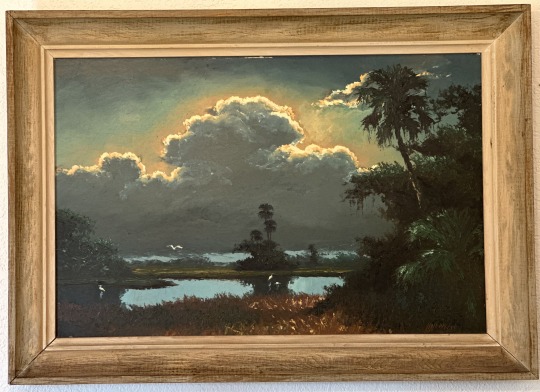

youtube
Summer in the Slough
Harold Newton
Oil on Masonite, Framed
1953-1958
In 1958 my grandfather, a traveling businessman, purchased this painting on the side of U.S. 1 in Fort Pierce, Florida from the artist, Harold Newton, for $35. Harold Newton was one of the founding members of the now-famous Florida Highwaymen. Thus dubbed because of their necessitated practice of selling artwork on the highway. The Florida Highwaymen were loosely grouped, African American landscape artists who were derided for their race and lack of formal training. During his travels, my grandfather purchased five of Newton’s works that remain in my family. All the paintings are untitled and undated. I have called this piece, “Summer in the Slough” because it is a sight so familiar to me from my childhood in the sloughs of Devil’s Garden, Florida. I feel particularly fortunate to have this piece due to Newton’s frequent representations of the coastline of his home in Fort Pierce. This backwater deviation is precious to me personally and in its rarity.
I attempted to re-create Newton’s Summer in the Slough despite my genuine lack of training. I cobbled together every random technique, barely remembered from academic art classes, in an attempt to portray the work with an exaggerated focus on the upper rim of the massive Cumulonimbus Clouds.
The first step in my process was to divide the card paper into sections that roughly approximated the space occupied in the original. Then I pencil sketched the shapes of the main features of Newton’s work. I chose to wash in the main color components with diluted acrylic to avoid obvious stroke marks. Finally, I experimented with crayons, colored pencils, markers, sharpies, and even glue, and glitter until I trial-and-errored my way to a passable facsimile of Summer in the Slough.
I intentionally exaggerated the brightly colored focal point of the clouds. That attribute has always been the most powerful aspect of the painting for me. The lightening of the colors surrounding the clouds in the painting creates a sense of drama and intensity, which has a significant impact on the emotion of the piece. The contrast between the dark, ominous clouds and the lighter, brighter areas around them creates a feeling of tension and anticipation. A massive storm is brewing. This evokes a sense of unease or foreboding and feels as though something powerful and potentially dangerous is about to happen.
At the same time, the use of lighter colors around the edges of the clouds creates a feeling of hope or optimism. The sun is very evidently still present. Its indirect aura indicates that the storm will pass, and the sky will clear again. This tension between opposing emotions creates a complex and nuanced emotional response, as we navigate our own feelings of fear and hope in response to the painting. Overall, the lightning of colors surrounding the clouds adds depth and intensity to the piece. Summer in the Slough is the perfect antidote to my occasional stormy moods. Its menacing cumulonimbus perfectly captures my darkness. The evident silver lining encapsulates my overriding optimism.
0 notes
Text
Re-enactments
Francis Alys and Rafael Ortega
Centro, Mexico City 2000
In 2000 Francis Alys asked his friend and fellow artist, Rafael Ortega, to meet him at a shop in Centro, Mexico City. Alys illegally purchased a gun, loaded it and left the shop, with Ortega following. Ortega, a cinematographer, captured Alys’ “performance” on his handycam.
Alys’ stated purpose was to walk the bustling streets of Centro carrying the firearm openly until “something happened.” This is a central and recurring theme in Alys’ work – the uninformed public are unknowingly conscripted to perform a vital role in the execution of his art. The bystander’s reactions are integral to the direction his work takes and to the content throughout.
Alys and Ortega display two filmings of the event side-by-side, simultaneously. The first is the original performance, the second is a choreographed, heavily edited re-enactment of the event. The two films are never separated, they are intended to be viewed as a whole. Alys wishes for his audience to compare the two. The first film (on the left) is the “real” performance, with none of the participants aware of Alys’ intent as an artist. The arrest is real, the reactions authentic. The second film (on the right) is re-enacted with police cooperation.
The final composition of Alys’ piece clearly directs the audience to compare the documentation of an event with a reproduction of the same event. Alys is commenting on the way documentation alters the experience of an event juxtaposed against the experience of a staged rendering.
Unfortunately, Re-enactments is frequently interpreted as a social commentary piece focusing on the criminal climate of Centro in the 2000s. Most notable are the ease with which Alys obtains the firearm, the lack of reaction from the citizens, and the unseen negotiation to enlist police cooperation for the second filming. Alys later discusses his choice of subject and its impact on the audience. Alys admits that the salacious selection of a gun should have been replaced with something innocuous. Alys proposes that instead he should have chosen a banana peel.
The striking component that I experienced was my lack of perception of the editing of the second film. There are obvious cuts and editing on display in the re-enactment. My experienced television viewer’s eye did not detect them on my first or second viewing of the event. I have become so familiar with directorial devices, that they go entirely unnoticed without conscious effort on my part.
0 notes
Text
HAMLET ACT 1 SCENE 2
The version of Hamlet that I selected does agree with my interpretation. Hamlet himself is a deeply distraught young man frustrated by many factors. His beloved father has just died. His mother hastily remarried Claudius, Old Hamlet’s far inferior brother. His grief is being diminished by those who should be supporting him. Claudius’ brother and Gertrude’s husband is dead. If they cannot share in his mourning, they can at least refrain from belittling him for it. The actor portraying Claudius is successful in depicting him as an arrogant, overbearing man. Gertrude is barely seen at all, hidden behind her brooding son, next to a man who is clearly using her.
I have always loved this scene; there is no great action, no grand soliloquy. I believe that in his subtlety, Shakespeare’s genius is most clearly seen in these seemingly innocuous passages. There is so much happening, as the trio engage in dialogue. Claudius is being developed as a true blocking character to Hamlet’s angsty youth. He has just dismissively rejected Fortinbras’ demands and blithely blessed Laertes’ desire to return to school. In the following breath he bullies Hamlet for his grief and withholds his blessing for Hamlet to return to school. Gertrude’s character is being revealed as subservient whose value comes predominately from the affect she has on the men in the play.
Hamlet’s lines are the most telling. He curtly and concisely expresses his distaste for Claudius in general and the idea of him as his mother’s husband particularly. He will never accept him as a father figure. He admonishes his mother’s use of the term, “seem,” countering that he cannot fathom his appearance accurately reflecting his dark inner turmoil. He also provides brilliant foreshadowing with “For they are actions that a man might play.” I am never quite sure, when I read those words, if Hamlet is declaring his strategy, or if I am witnessing the birth of his plan. When Hamlet tells his mother, “I shall in all my best obey you,” he is offering an unenthusiastic consent and hinting at a more profound usage of, “obey.” In Hamlet’s mind, obeying his mother and father in the biblical sense entails protecting his mother from herself.
0 notes
Text
0 notes
Text
La Jetee was extremely effective in making me feel uncomfortable. The entire short film is a series of still shots relying almost solely on cuts. The only style of cut that I did not recognize in the film was the continuous cut. As there was little action within the film's scenes, there were no action continuous cutaways. Every other example of cut was present. The match cut method utilized during the experiment segment with injections was the most effective at building tension. The tension was aided by skillful manipulation of middle shots to closeups. The long shot seemed reserved for the Jetty itself where the protagonist was most at ease, until his final return. Near the middle of the film, La Jetee finally lived up to its inclusion in the motion picture category by featuring a jerky live action sequence of The Woman waking. The absence of motion throughout the other segments of the film lent significance and surreally to the brief example.
0 notes
Text
0 notes
Text
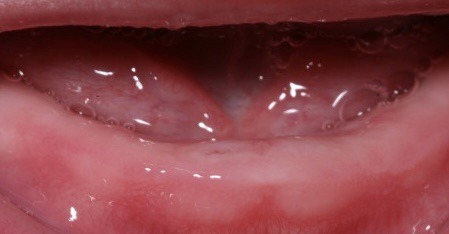
Odontiasis
Arrgghhh! Something is wrong. Very, very wrong. The wrong is everywhere! “Otherme, help,” I beg, “help, NOW! Hurry!” Finally. Here we are. “Please, Otherme,” I whimper, “make the everywhere wrong go away!” the Warmth flooding as we rise up and relief- oh no! It isn’t gone, the wrong is still here. Otherme will fix it, I just have to explain that it’s still there.
“It is awful,” I begin as we enter the cozy, soothing rhythm of up, “there is a terrible, loud feeling in me. It’s cold and empty can we make it stop now, please?”
“Shhhhhhhhhh.Shhhhhhh,” breathes Otherme in our ear as the world becomes suddenly too, too bright. We hate the brightness. We break apart and one of our hands begins to fumble at our low part.
“Stop that,” I command, although none of our hands ever listens to us, especially when we’re upset. Maybe it’s time for a physical approach. We arch up. Bat at the hand with some other hands. We thrash our low part, it’s no use.
After an eternity, it is over. Yessss. The soft place gently catches us and we are pulling the sunshine into our mouth…
This can’t be happening! The wrong is worse! This has never happened before. The sunshine always makes everything better. There can be only one explanation: this is the new us. We will feel this way forever. The world must be notified of this gross injustice.
“No, no, noooooo! This. Is. Unacceptable,” just getting warmed up to air my grievances. “Make it stop, now”, I demand to whom I do not know. “The sunshine makes it worse. I cannot bear it.”
“Hmmm, hm, hmmm, hmm,” Otherme chimes in with a resigned murmur. “La, la, mmmmmhhmmm,” we harmonize, and the billowing vibrations lull us into an exhausted stupor.
Where is Otherme? We were just here. Why is there something in our mouth!? Ouch, its slick sharpness on our tongue. Here we go again. “Othermeeeeeeeeee!”
In case I didn’t convey it well, this is a first-person narration of a tooth cutting. Based on current research, I tried to include a six month old infant’s inability to extricate his identity from that of his primary care giver. I chose “Otherme” as my name (even though it’s a bit on the nose) because it has “mother” in it and I like the cadence of the fictitious word. I hope that “Otherme” provided some foreshadowing of the event and added context while building the narrator’s character and unique perspective. I know, that’s a lot to ask of a name.
First-person narration is challenging enough to write, and I decided to blur the pronouns on top of that. I stuck to “we, us”, unless I was using a dialogue tag where I thought “I” felt more immediate. I tried to maintain age/development appropriate concepts of self and situational awareness throughout the narration and switched to more sophisticated speech language. I utilized the symbol “sunshine” for breastmilk to (hopefully) portray the benevolent, life-giving necessity that it is. I wanted it’s ineffectiveness to raise the action while providing a clue to the ultimate outcome. The metaphorical “billowing vibrations” are what I’ve always imagined my son perceives when I hold him pressed to my chest while it is expanding and contracting with my singing breaths. I called our rocking, “the cozy, soothing rhythm of up” because my child demands motion while being held- I don’t think he recognizes that he’s okay until we are swaying. It also allowed the action to fall in my organic narrative, before the final plot shift. I intentionally left my vignette unresolved to communicate a realistic portrayal of early childhood: as soon as one issue is remedied, another arises- also inexplicable and brand new.
This story was important for me to attempt because my son cut his first tooth when he was six months old. I tried to put myself in his position of being unable to determine what was happening: incomprehensible to why his other half wasn’t in sync and convinced that this pain was a new and permanent aspect of his existence. I couldn’t do it. My powers of empathy utterly failed me, it was too large a leap. This is the closest I’ve come to understanding the abject horror of it.
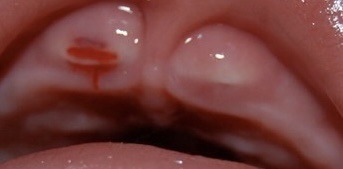
0 notes
Text
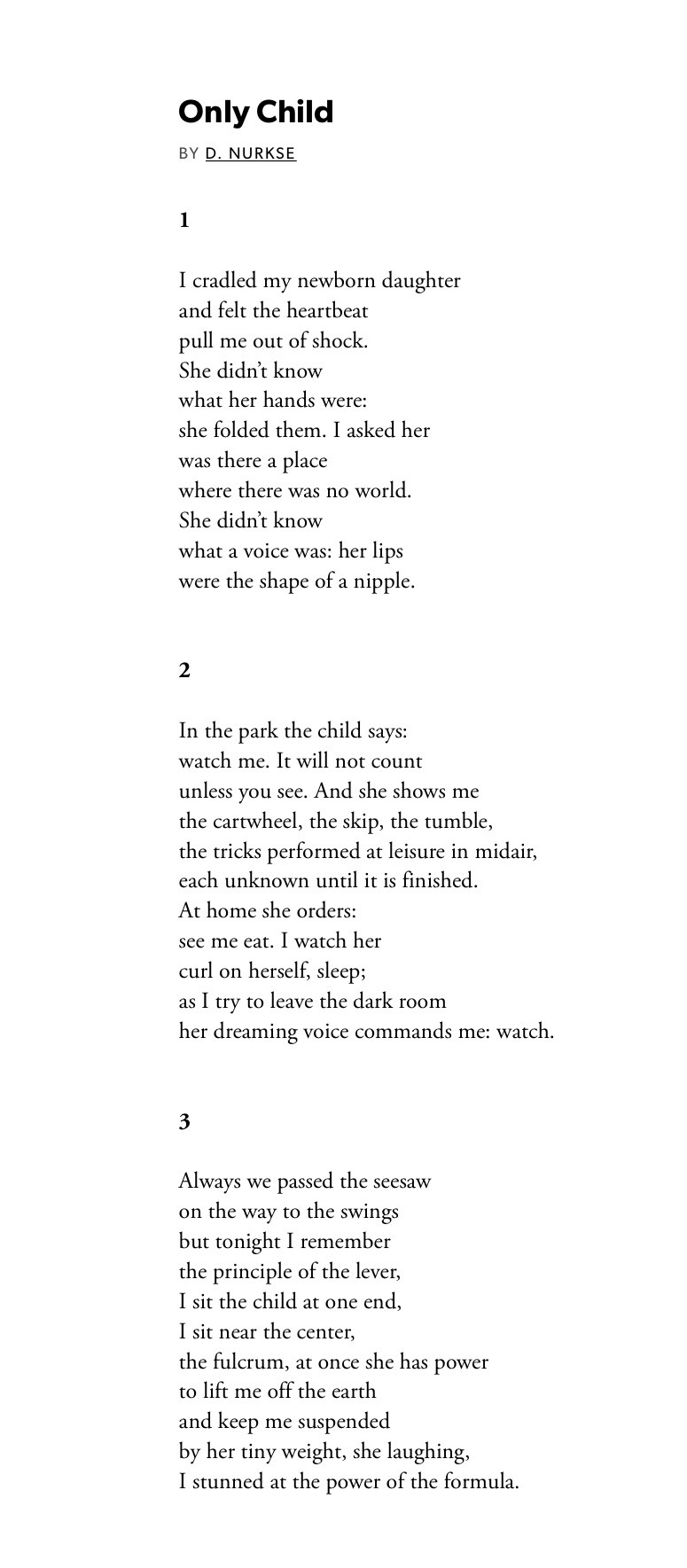
I am usually not particularly drawn to poetry. It’s nuances escapes me. I am familiar enough with poems to understand that they generally involve feelings. I felt it would be best to begin a discussion on poetry by selecting a subject matter that I am passionate about. “Only Child” by D. Nurkse is a poem about early childhood from the perspective of a mother. The opening line immediately flooded me with the remembrance of birthing my son. How deeply shocking and tender the experience was for me. I even remember becoming convinced that my son had a profound knowledge of the universe that would fade, in direct proportionality, with his ability to speak.
My son is now 15 months old, the age when a mother’s witness is crucial to a child’s sense of well being. The sense of urgency that a child feels at this stage for their efforts to be seen is only equaled by a mother’s urge to turn away, or stop the child. Every time my son climbs steps while vehemently rejecting my attempt to hold his hands, I stop breathing and ready my body to spring into fall prevention.
Our bedroom routine includes kissing him goodnight before I lay him down. Then I tuck him in and press a kiss to his cheek with my fingertips. Followed by two steps from the crib, turning and blowing a kiss. Reaching the door, he is up, waiting to make sure I haven’t forgotten him. I push two more kisses through the space between us. Out of the door, latch the gate, push the door to a slender crack, two more kisses breathed through the narrow opening.
The metaphor of the seesaw in the final stanza struck me as perfect imagery to depict the degree of power a child has over his mother while being simultaneously powerless.
After my initial reaction to the poem, I decided to dissect it to glean all of the meaning I could from it. The first thing that I noticed was the punctuation. There were several times that individual lines in the poem abruptly ended, only to have the thought continue in the next line. The following line dramatically altered the meaning of the preceding line and the the thought on a whole. I discovered that this technique is called enjambment. When a sentence is interrupted by the formation of a new line, without a grammatical pause, the author intends readers to hurry to the next line for clarity. It works. Rushing to complete the thought interrupts the rhythm of the poem and causes additional emphasis to be placed on the lines, e cause they demand to be reread as a whole. Conversely, when the author places punctuation at the end of the line as an end stop, the reader pauses with time to reflect on the lines. That discovery led me to the next device: caesura. Caesura come in two forms, the masculine and the feminine. A masculine caesura occurs after a stressed syllabus, typically a consonant. They effect is hard, in this poem the masculine caesura in the line, “the cartwheel, the skip, the tumble” are so pronounced that the words feel like a punch. The feminine caesura in the line, “unless you see. And she shows me” flows gently together. It enhances the feeling of child and mother merging into each other.
As I began to understand that the nature of the pauses indicated the Turkse’s intentions, I became interested in the meter of the poem. I placed stressed/unstressed markers above the syllables. I think that the poem is in iambic pentameter, roughly. What I found to be most interesting was that the meter and the rhythm disintegrated during the most powerful lines.



1 note
·
View note
Text
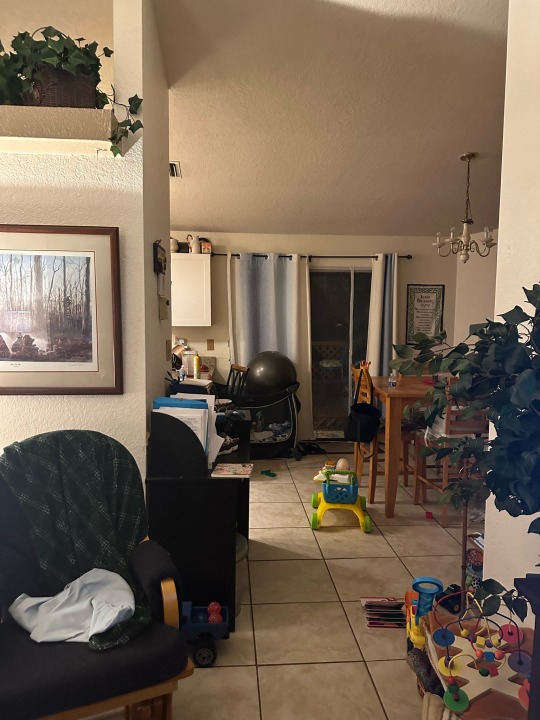

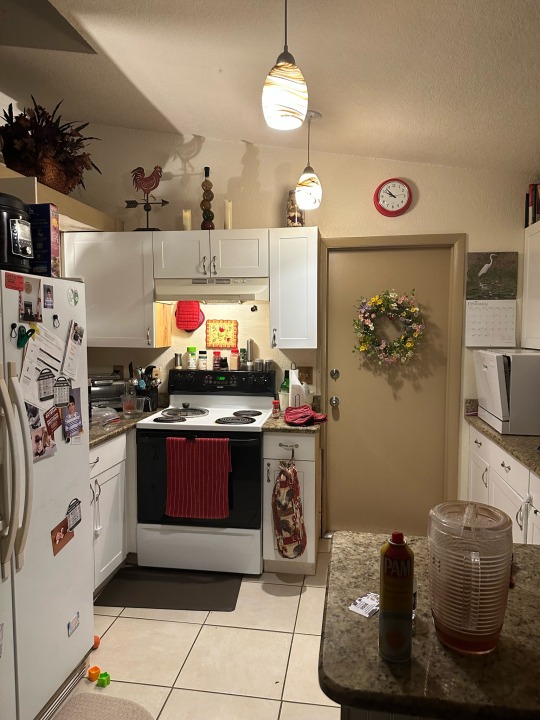
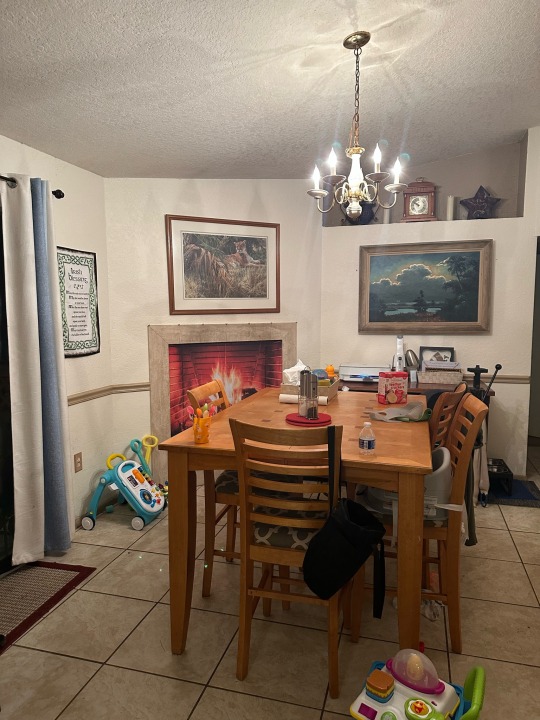
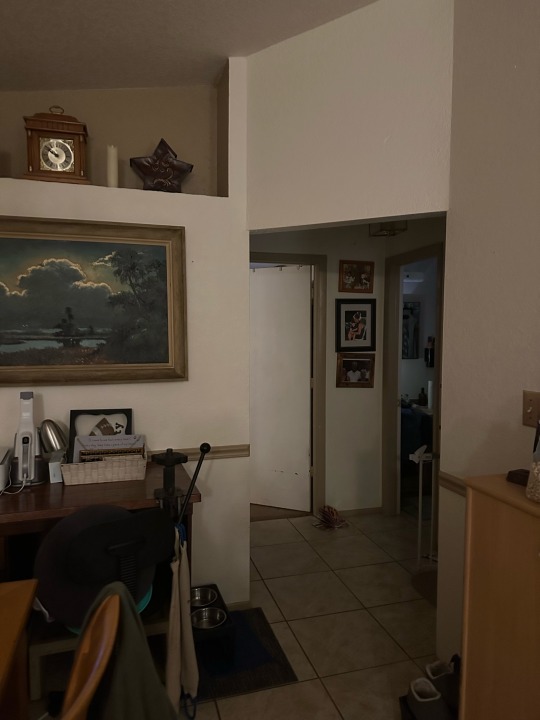
Architectural Interiors
The space that I currently reside in is a quaint, single-story, mature stucco ranch home that is fairly common in Florida’s neighborhoods. The front entrance to the home is bracketed by an attached single car garage on the left and the living quarters on the right. Immediately upon entering the home lies the family room with a view straight to the obligatory sliding glass doors and porch beyond. The open floor plan includes a kitchen that shares one interior wall with the garage and one cut-out interior partition wall with the living room. Along the exterior wall, adjacent to the kitchen, an open dining room is situated with a corner fireplace. At the rear of the common space the master and guest bedrooms and baths offer the only truly enclosed chambers. It is difficult to separate some of the damage caused by Hurricane Ian from the natural deterioration of an older home. The result is a domicile that displays disrepair with sadly contrasting potential. With a lot of superficial attention (flooring, light fixtures, and freshly painted, repaired walls) this home could be the quintessential starter home. The comfort of a familiar ranch style layout is complemented with unique interior features. The partition wall of the kitchen/living room has two cutouts that provide excellent interior design opportunities in addition to the connectedness they offer. Continuing this open and inclusive theme is a skylight that integrates the natural light from the front bay window and the back-facing sliding glass doors. There is an additional unique cutout at roof level of the wall shared by the living room and master suite. This cutout is not a pass through, but a recessed niche, providing the suite with requisite privacy. Although the overall space is small, the thoughtful inclusions and open common area provide a cozy, accessible abode.
A space that I particularly enjoy inhabiting has many of the same open elements of my current house, but on a grander scale. My current residence is roughly 700 square feet. My childhood home was 3875 square feet. It was designed to reveal the importance of the family group and the influence of nature. I have included floor plans to assist in the visualization of this remarkable space. As my drawing proves-I am not an architect, but neither was the designer of my childhood home. Although it is also a ranch style home (albeit an L-shaped ranch) it boasts several features that I have never seen repeated. The angles of the two hallways portray a playful sense of continuum while simultaneously restricting the view to the bedroom entrances. The bedroom thresholds are also the only traditional style doors. The back of the house claims four sets of double French doors converging on two fenced acres. The closets are enclosed by double pocketed doors. The oversized twin front doors are protected by a columned entryway. Even the guest bath possesses a single exterior French door beset with delicate stained glass that both obscures the interior and floods it with tinted light. The master bath shares this effect in the form of an oversized stained glass panel depicting a bird of paradise. Every exterior wall is studded with views from glass paned doors or extra large windows. The effect is to invite nature into the home regardless of one’s position within the structure. The common space of the kitchen/family/living/dining rooms are divided with a pony wall upon entering and varying floor textures throughout. Tile weaves from the entryway to the hallways and pools in the kitchen. Carpet delivers the only definition of family, living, and dining rooms. The overwhelming sensation is that family life should occur in togetherness, while living spaces are private sanctuaries for sleeping.



0 notes
Text
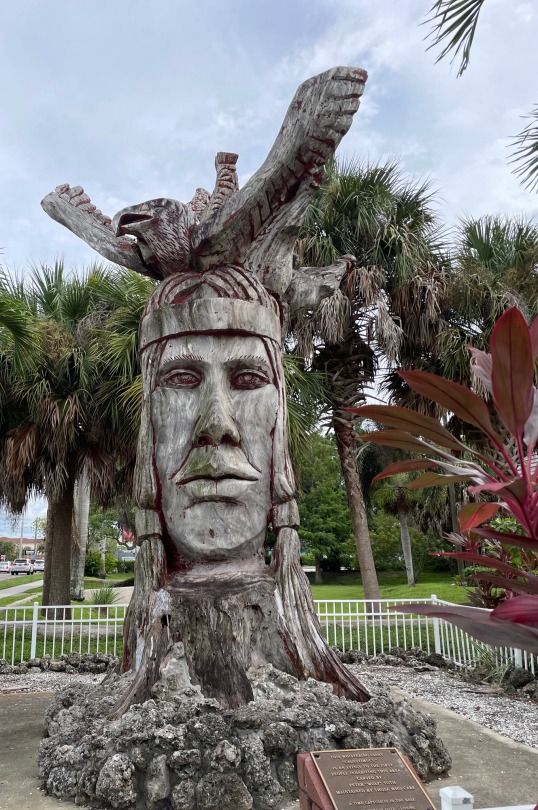
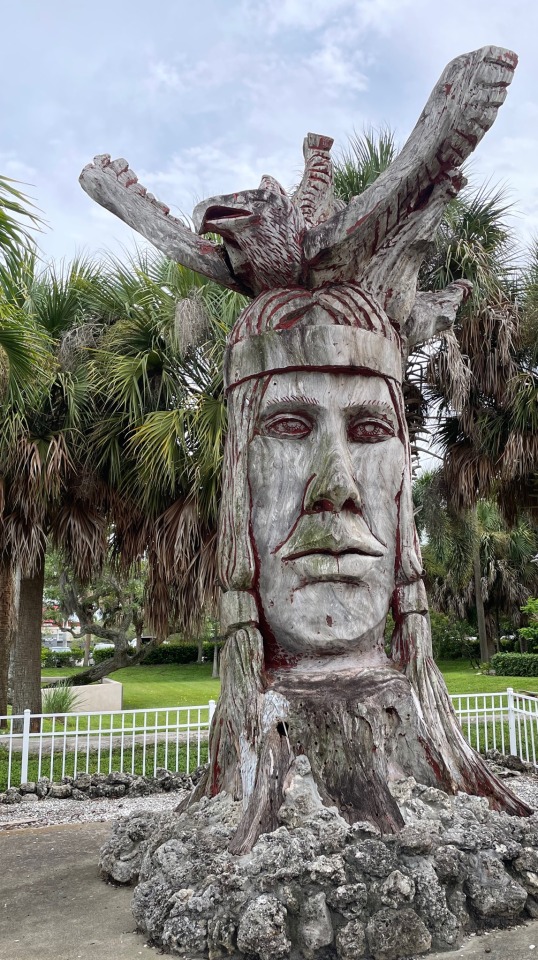
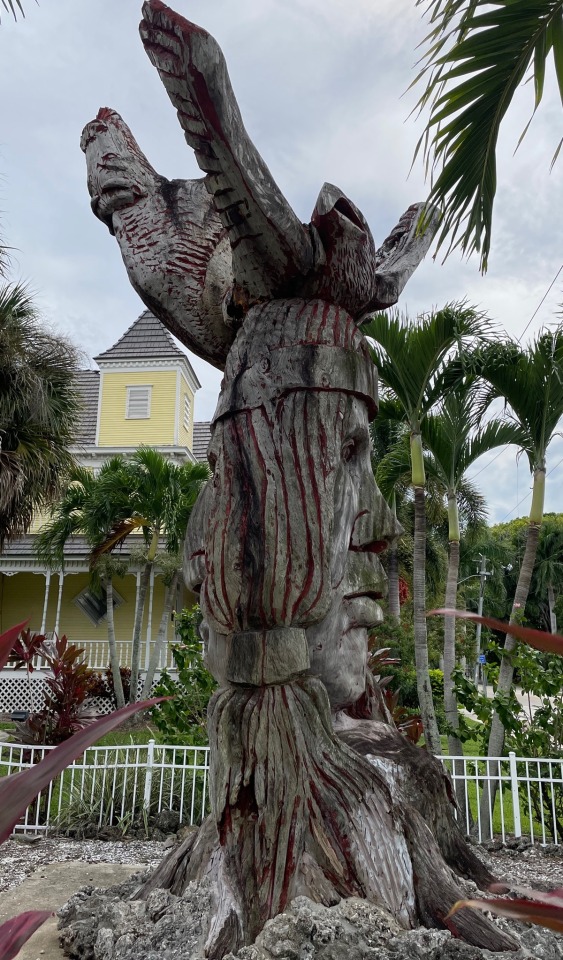
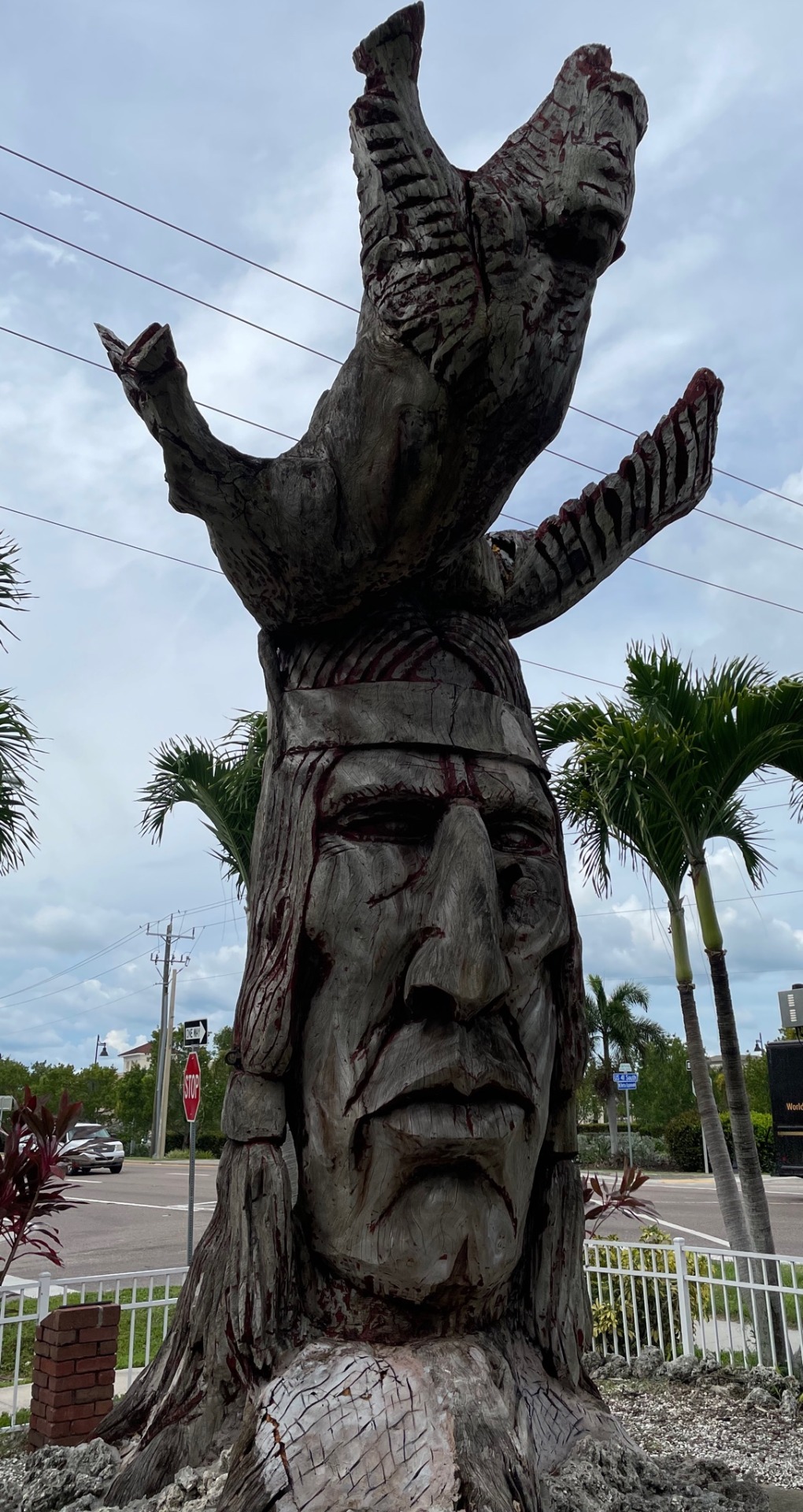
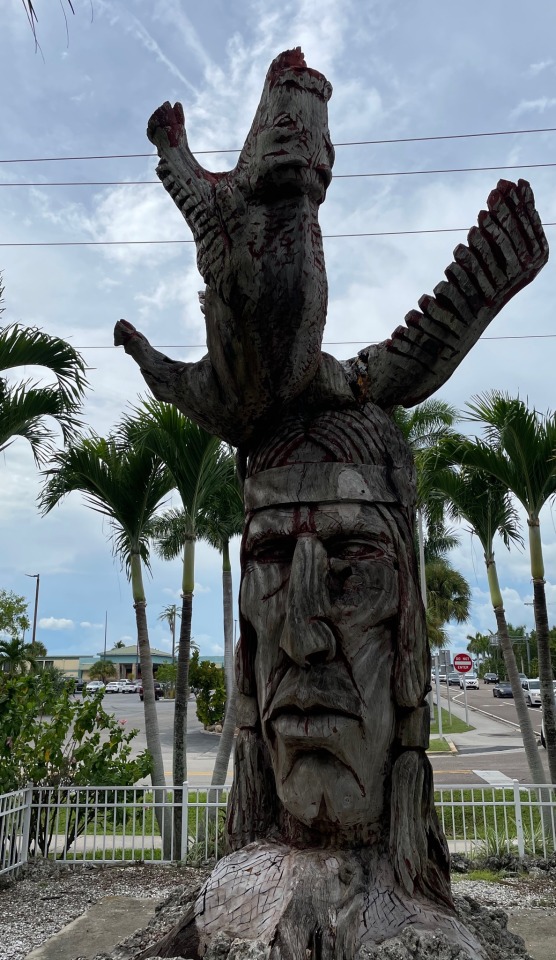
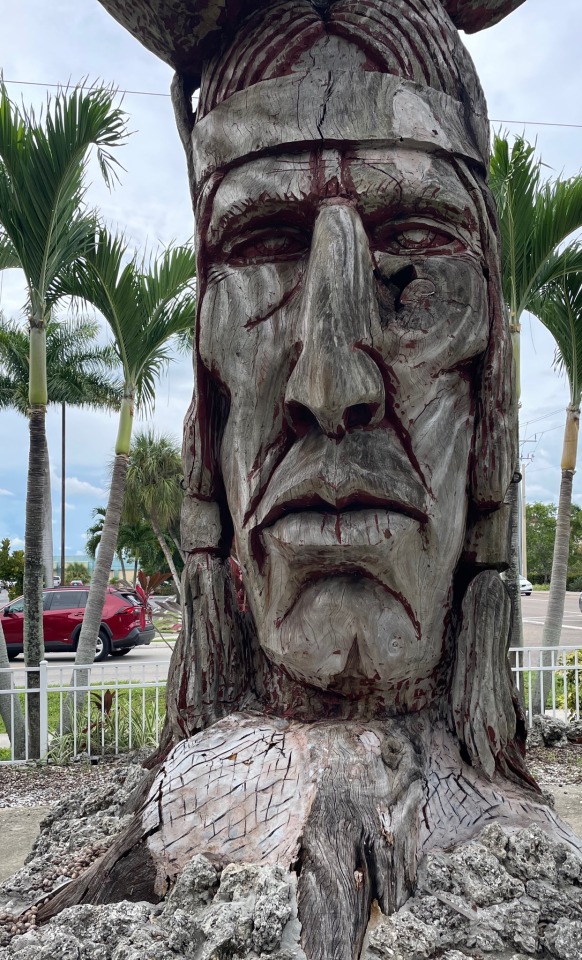

Calostimucu is a twenty-foot-tall statue carved in the round by Peter “Wolf” Toth. The fascinating story began in the seventies when Fred Babcock discovered a very large, dead monkey pod tree on his property overlooking the Charlotte Harbor in Southwest Florida. Fred Babcock had become aware of and impressed by, the sculpting talent of Peter “Wolf” Toth during a visit to La Jolla, California in 1972. La Jolla was the site where Toth had created his first massive sculpture of an Indian head. It was during his work on the cliff-carved stoned visage that he formulated his plan to shape a “Whispering Giant” Indian head in every state of the United States. Toth’s next stop was his “hometown” of Akron, Ohio where he elected to transition to sculpting in wood for the remainder of his series. Peter “Wolf” Toth was not born in Akron; his family fled Hungary in 1956 to escape Soviet occupation. Toth was captivated by the American Indians and sympathized with their mistreatment and oppression. He is quoted by Roadtrip America as explaining, “This (the statue) is my concept of the Indians of this area. I study the Indians of the area, then visualize an Indian within the log. It is a composite of all the native people of the state.” (Thurman 2010) Which perfectly mirrors what he achieved in Punta Gorda, FL.
Calostimucu is a composite of the Calusa and Timucua that were prevalent in this area prior to white expansion. Calostimucu is the tenth statue completed in Toth’s “Whispering Giant” campaign. It is unique in the dual nature of the round. It has two faces and two symbolic animals jutting from the crown. The face confronting all Southbound traffic on US 41 is that of a maiden. She looms, at twenty feet, stoic in the deep hewn lines bracketing her mouth with expressive deep-set eyes. She has a generous mouth situated above a squared jaw in an elongated face. Twin braids conceal her ears with an eagle positioned along the part in her hair. The eagle appears to be in distress: either falling from the sky or failing to gain flight. Opposite the maiden is the Chief. He strikes me as resigned in anger. The deep lines of his face and lips are emphasized by lingering red paint that has all but worn off the superficial exteriors of the monkey pod. I have attempted to capture what I found to be a compelling feature of the chief’s face. Toth chose to allow the natural grain of a burl to act as the undereye pad of Calostimucu’s male left eye. Knots in trees occur as branches are severed, or broken, from the living tree. The burl in the wood is a remnant of a lost limb, a scar, but also proof of the tree’s survival. I doubt that its inclusion was accidental. At the base of the figures are roots that Toth took pains to crosshatch, effectively concealing the wood’s grain. Juxtaposed on the opposed eye is a slash that draws further attention to the organic knot. The overall impression is of a man bruised and angry, calmly planning his next move. The animal form projecting from the Chief’s head is a buffalo. It is stationed on its back, clearly in distress, with four legs clawing at the sky. This corroborates the predicament of the eagle.
I grew up with this statue at the foot of Charlotte Harbor bridge. I remember waiting to see the Chief’s face as I crested the peak. I do not remember if I ever saw it covered in red paint. The reason that I chose this work is that it has always spoken to me. Whispering about rage and self-control. The property that Calostimucu originally stood on was severely damaged in Hurricane Charley. As the decision to relocate the statue was being considered in Charlotte County, there was a controversy concerning the composition of the figures that I had never considered. Citizens were disturbed by the buffalo’s anatomical correctness. I found the rank pettiness deeply offensive and had not been to visit my old friend since his face was turned away. I am extremely grateful to have had this incentive to revisit Calostimucu and am proud that it still remains. For me, Calostimucu epitomizes the community it resides in. Citizens appreciate the artistry and even some of the history. But they don’t want to look it full in the face. They prefer to turn away and pretend that something obvious, true, and essential isn’t there.
Thurman, G. (2010, October). Sculpture by peter wolf toth in winslow, arizona. Peter Toth sculpture in Winslow, Arizona. Retrieved September 17, 2022, from https://www.roadtripamerica.com/roadside/Peter-Wolf-Toth.htm
1 note
·
View note
Text

Untitled, 2013
Nasrollah Afjei Iranian
2013
I have chosen the abstract art Untitled, 2013 by Nasrollah Afjei to attempt to participate in. Using my newly acquired knowledge of artistic sensa (line, color, texture, space, shape, light, shadow, volume, and mass) I will discuss my experience as I recall it.
My initial impression is that of gently flowing lines. The movement is reminiscent of the aquatic; it brings to my mind the motion of water as viewed through a porthole, adrift, in calm seas. It seems to be placidly rocking, the tight eye space of the frame suggesting a vastness just beyond view. The lines prove to be the absence of paint. The stark white of the canvas is an element of the painting itself. The texture, at first, appears to be smooth. Upon closer inspection, the bare canvas again reveals itself within the sweeping color. This also sparks in my imagination nautical references- the peculiar appearance of water in motion- aerated liquid. The colors are earthbound ochres, browns, gold, and bronze. The lines intrude and I am prompted to recollect the whorls of grain in raw-cut timber. Once I appreciate the lines as nude canvas, I can’t unsee them. Now I perceive the shocking white space at the bottom right of the canvas as fingers probing into a viscous mass. Maybe the fingers are disturbing the volume and launching it all into motion. Maybe they aren’t fingers at all, but a mountain with the wind rushing down its face. The painting has a rough symmetry if viewed with its axis running from the upper left corner to the lower right. It’s the rough approximation of symmetry found in nature, not the humanity-contrived exactness of a sheet of paper folded in half. The lower right of the canvas feels like it has the greatest mass, despite its lack of paint. The truly solid digits of white are emphasized by the only solid application of dark, earthy paint.
After my period of participation with Untitled, 2013 I read the Met Museum’s description which revealed Afjei to be a trained calligrapher who had painted the Persian word “eshq.” Eshq translates to “love” in English. I found this revelation to be entirely satisfying. There is nothing more natural than love.
0 notes
Text

REPRESENTATIVE WORK
Ancient Near Eastern. Female Figurine, late 3rd millennium B.C.E. Terracotta, 5 1/2 x 3 9/16 x 13/16 in. (14 x 9 x 2 cm). Brooklyn Museum, Gift of Helena Simkhovitch in memory of her father, Vladimir G. Simkhovitch, 72.133. Creative Commons-BY (Photo: Brooklyn Museum, 72.133_PS2.jpg)
https://www.brooklynmuseum.org/opencollection/objects/98871
Brenda Shave
After reading the first three chapters of the book, Humanities Through the Arts (Martin, 2023), I was impressed by the academic approach to art outlined by the authors. This new (at least for me) method of experiencing art reinforces my hope that, with a little knowledge, art can be accessible to me beyond my naïve, “Do I like it? Do I understand it?” mentality. I was particularly struck by the idea that our appreciation of a particular work can change over time. As we mature, our sense of values frequently shifts. The art work remains the same, but we gain experiential perspective and , sometimes, more information about the work, it’s creator, and context in time. So, how much involved in art appreciation is actually about ourselves?
My representative work, Female Figurine, is a clear example of a shift in my frame of reference having a drastic effect on my regard for a particular group of works. Before becoming a mother, I viewed Female Figurine as a rudimentary, unsophisticated example of art that I did not understand. For me, the value of any particular piece was rooted in the amount of skill and talent required to create its form. Essentially, if an artwork could potentially be duplicated by me, it was not valuable. Female Figurine reveals the importance of art beyond its form. The lack of facial features no longer conveys to me a lack of skill, but the loss of self in becoming a mother. The exaggerated depiction of reproductive regions draws my eye to what is important for a child. Maybe this is how my son saw me in his first few days of life? They also emphasized the massive alterations of my body after giving birth. I absolutely identify with the sense that my reproductive organs became out of proportion with my previous experience of them, both physically and emotionally. Female Figurine’s arms are rendered as oversized loops. This mirrors my sense of urgency to protect my son against factors that are so much larger than myself. The tiny figure of the child displays the crushing vulnerability of newborns. Its amorphous form speaks to an unknowable potential. While I could possibly make a passable copy of this figurine, that’s what it would be: a copy. The emotional impact of this simple sculpture and the volumes it speaks of motherhood are profoundly beyond my ability to convey.
0 notes
Text
There is an entire world of beauty, wonder and majesty that I have been excluded from. This paltry trio of adjectives doesn’t justly represent the declarations of appreciation that abound in the realm that I have yet to reach. I am sadly suspicious that the obstacle that has barred my entry might be my abject ignorance. I am baffled by the value of many great works of art (Jackson Pollock comes to mind). I am mystified by the musical lure of opera (I have also never listened to one in entirety). The function of architecture appeals to me while the form persistently eludes me. I have lately become fearful that these examples suggest that there are even more fields of art that I am completely unaware of.
Adventure and the excitement of discovering new things bring me immense satisfaction in this amazing life. I like to believe that I am open minded and eager to learn as much as I can about a myriad of topics that I have been lucky enough to encounter. I have gleefully dived into the the intricacies of training working dogs; attempted to master the soroban abacus; even delved into the untidy hobby of batik. I have an eclectic assortment of interests and have always found that increasing my understanding necessarily increases my enjoyment. So why have I resisted deepening my knowledge in the arena of the arts, particularly when there is such an abundance of available information about it? Perhaps it is because I am intimidated by the vast scope of the subject. Maybe I just don’t know where to begin.
I have decided that I am going to begin today. I am going to methodically examine as many aspects of the arts as I can devote my attention to in the next several weeks. The best part- I am going to let myself be led by experts in the field, surrendering to their command of my focus. In this blog, I will attempt to share my experiences with a fresh perspective and (hopefully) convey my excitement of discovery.
0 notes

